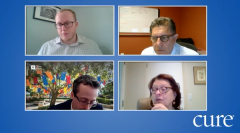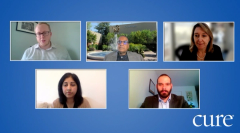
Educated Patient® Lung Cancer Summit Radiation Advances Presentation: June 25, 2022
Watch Dr. Terrance M. Williams, from City of Hope, discuss radiation advances during the CURE Educated Patient Lung Cancer Summit.
Over the past two decades, radiation therapy has advanced greatly, allowing patients with lung cancer to receive a higher dosage of treatment over a shorter period of time, without damaging organs and non-cancerous tissue around the tumor, while still being “highly effective,” according to an expert.
Dr. Terrance M. Williams, professor and chair of the Department of Radiation Oncology at the City of Hope Medical Center in Duarte, California, discussed the advances made in radiation therapy over the years and how it has benefited patients at the CURE® Educated Patient® Lung Cancer Summit.
Williams described radiation as a type of therapy that cannot be seen, felt or heard. During radiation, high packets of energy photons are directed to target the tumor, while avoiding normal tissue, by the radiation machine. The mechanism of how it works is by causing double stranded DNA breaks in the tumor cells, which can’t be repaired and ultimately die.
Not damaging the normal tissue is a big part of radiation therapy, however it was not always able to be avoided, he said. In the past, radiation therapy was not as precise, causing damage to the normal tissue and organs around the tumor.
“I would say in the past our ability to concentrate the tumor and minimize damage to normal surrounding tissue or organs was not as good as it is now,” Williams said. “Our techniques are more precise for (the tumor). As a result of that, we can minimize that bystander collateral damage (caused by the radiation) to the normal tissue and increase the dose to the tumor making it more effective.”
These advances have allowed the therapy to be done in a shorter amount of time, which benefits the patient, but at a higher dosage.
“For stage 1 lung cancer, for example, in the past it might have to be 35 treatments over seven weeks, Monday through Friday. Now we can deliver that in three to five treatments over one to two weeks,” Williams explained.
Advances like these have also been “highly effective” in treating the disease as well, he added. One advance that has been significant in the space for stage 1 lung cancer is stereotactic body radiation therapy (SBRT) — which has shown disease control rates and cure rates comparable to that of surgery, which has been the “gold standard” for many years.
“Over the last decade or two we’ve improved our ability to treat stage 2 and stage 3 lung cancer with this work and formal techniques, and cure rates have gone up and up,” Williams said, adding that there is even more to be learned on the horizon.
In stage 1 lung cancer, there are some clinical trials underway evaluating the combination of radiation therapy and immunotherapy to attack the tumor, “we’re very excited about the results of those trials,” Williams said.
In the stage 4 setting, there has been advances in better understanding how to use radiation in patients with limited metastatic disease. Some results are suggesting improved chances of the cancer not coming back and overall survival. Additionally, there are several clinical trials testing immunotherapy and chemotherapy radiation in small cell lung cancer, as well as radiation therapy in combination with newer immunotherapeutic agents.
“Those are some of the exciting clinical studies that we’ll be doing over the course of the next five years,” he said.
Staying educated on these advances and clinical trials in radiation therapy for lung cancer is important for patients because it allows them to have a conversation with their doctor and ask them the right questions, Williams concluded.
For more news on cancer updates, research and education, don’t forget to















